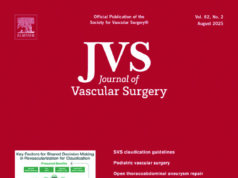
A new research letter underscores the need to improve long-term survival following lower extremity revascularization for chronic limb-threatening ischemia (CLTI), setting out a randomized controlled trial to examine the impact of coronary artery ischemia testing in these patients.
The letter, authored by Dainis Krievins (Pauls Stradins Clinical University Hospital, Riga, Latvia), Andrejs Erglis (University of Latvia, Riga, Latvia) and HeartFlow’s senior advisor for medical affairs, Christopher K. Zarins, was recently published online ahead of print in the European Journal of Vascular and Endovascular Surgery (EJVES).
Krievins and colleagues first detail that patients undergoing lower extremity revascularization for CLTI or claudication have “poor” long-term survival due to co-existing coronary artery disease (CAD), which they note is “often asymptomatic, undiagnosed and undertreated.”
Diving into the available data on the topic, Krievins et al highlight an “alarmingly high” mortality rate in these patients that is evident throughout the literature. They state, for example, that the recent BASIL-2 and BEST-CLI randomized controlled trials reported a five-year mortality rate for patients with CLTI that exceeded 50% and was three times higher than the risk of amputation. They also note a 10–12% annual mortality rate following lower extremity revascularization in studies including both patients with CLTI and those with claudication—namely SWEDEPAD, SAFE-PAD and VQI Vision.
The authors point out that the mortality rate in these patients is not only high, but has remained unchanged over the past 40 years, contrasting a “marked decline” in the mortality rate among patients with symptomatic CAD in association with coronary revascularization as a mainstay of treatment. Current annual mortality for patients with CAD is only 1–2%, the researchers point out, as per the ISCHEMIA, FAME 2 and SCOT-HEART trials.
Krievins and colleagues state that guidelines recommend no cardiac testing of patients without cardiac symptoms prior to vascular surgery procedures, despite patients with PAD with combined CAD having “invariably worse outcomes.”
Against this backdrop, Krievins et al detail that they have embarked on a multicenter, randomized clinical trial to determine whether non-invasive diagnosis of silent coronary ischemia together with ischemia-targeted coronary revascularization can improve the outcome of patients following lower extremity revascularization.
The SCOREPAD (Selective coronary revascularization in peripheral artery disease patients after lower extremity revascularization) trial, will enroll up to 600 patients with CLTI or severe claudication and no known CAD after successful open or endovascular lower extremity revascularization, Krievins and colleagues share in EJVES. The patients will be randomized to either coronary computed tomography angiography (CTA) plus computed tomography-derived fractional flow reserve (FFRCT; HeartFlow) with ischemia-targeted coronary revascularization in addition to best medical therapy (BMT) or BMT alone with no elective coronary revascularization, which they note is the current guideline-directed standard of care.
The primary endpoint of the trial is a composite of cardiac death, myocardial infarction (MI) and urgent (unplanned) coronary revascularization during two-year follow-up, the authors detail. Extended followup will continue out to five years.
“Patient enrollment began in February 2024 and more than 80 patients have been randomized so far,” Krievins et al report in EJVES, who go on to say that the trial is seeking to include up to 10 additional sites in Europe and the U.S.












